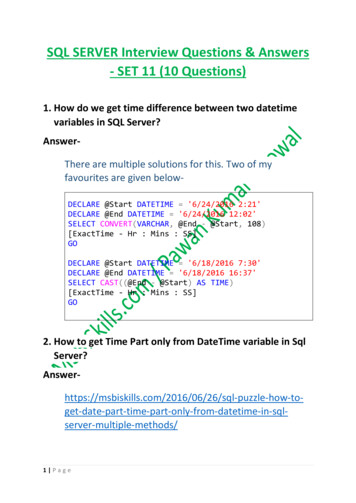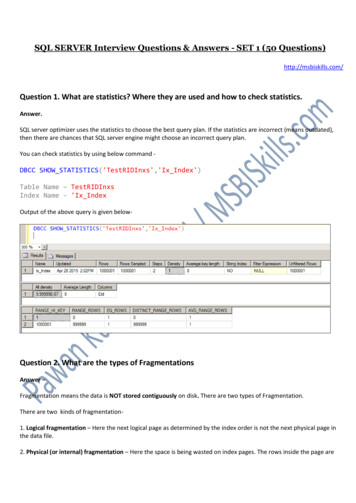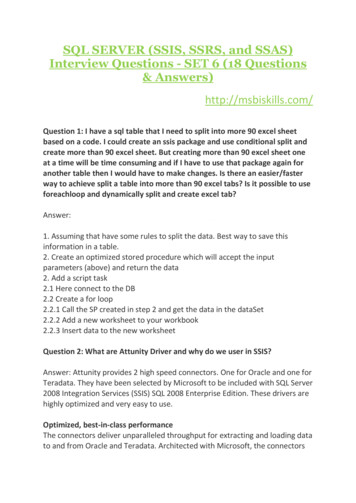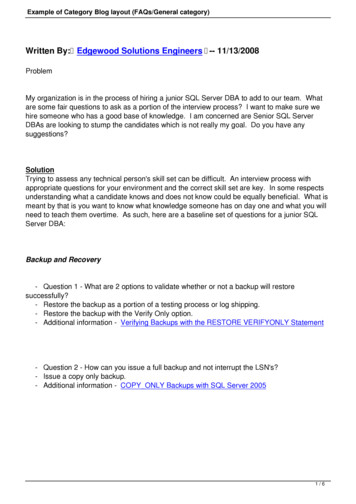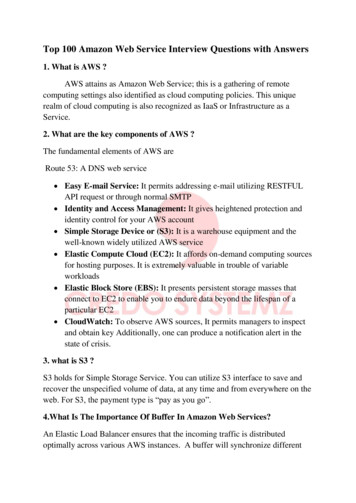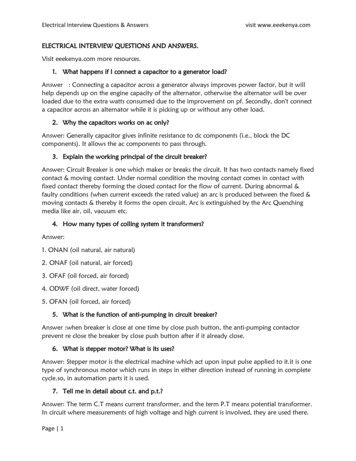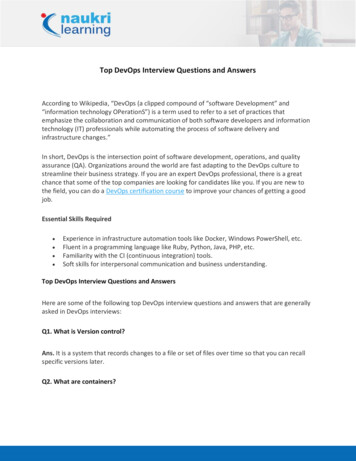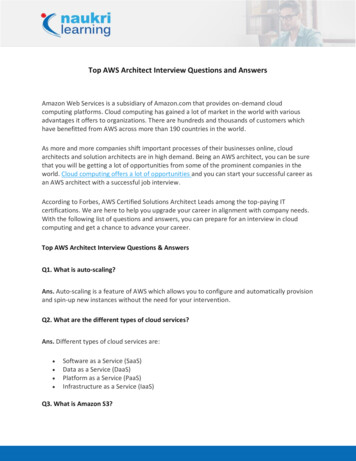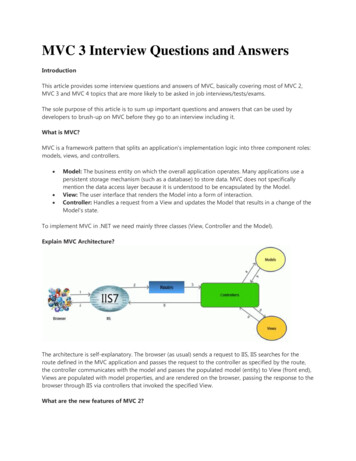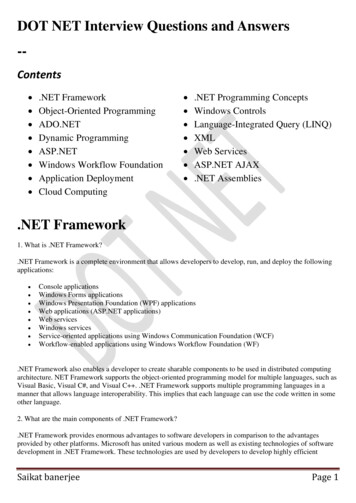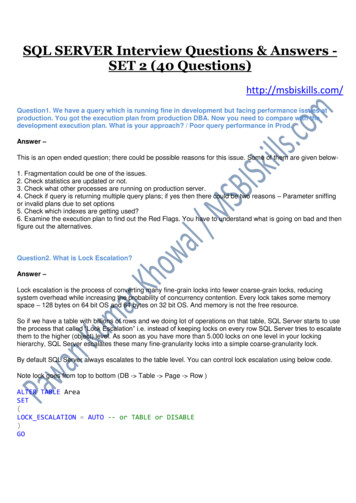
Transcription
SQL SERVER Interview Questions & Answers SET 2 (40 Questions)http://msbiskills.com/Question1. We have a query which is running fine in development but facing performance issues atproduction. You got the execution plan from production DBA. Now you need to compare with thedevelopment execution plan. What is your approach? / Poor query performance in Prod.Answer –This is an open ended question; there could be possible reasons for this issue. Some of them are given below1. Fragmentation could be one of the issues.2. Check statistics are updated or not.3. Check what other processes are running on production server.4. Check if query is returning multiple query plans; if yes then there could be two reasons – Parameter sniffingor invalid plans due to set options5. Check which indexes are getting used?6. Examine the execution plan to find out the Red Flags. You have to understand what is going on bad and thenfigure out the alternatives.Question2. What is Lock Escalation?Answer –Lock escalation is the process of converting many fine-grain locks into fewer coarse-grain locks, reducingsystem overhead while increasing the probability of concurrency contention. Every lock takes some memoryspace – 128 bytes on 64 bit OS and 64 bytes on 32 bit OS. And memory is not the free resource.So if we have a table with billions of rows and we doing lot of operations on that table, SQL Server starts to usethe process that called “Lock Escalation” i.e. instead of keeping locks on every row SQL Server tries to escalatethem to the higher (object) level. As soon as you have more than 5.000 locks on one level in your lockinghierarchy, SQL Server escalates these many fine-granularity locks into a simple coarse-granularity lock.By default SQL Server always escalates to the table level. You can control lock escalation using below code.Note lock goes from top to bottom (DB - Table - Page - Row )ALTER TABLE AreaSET(LOCK ESCALATION AUTO -- or TABLE or DISABLE)GO
Notes – You can disable Lock Escalation for time being, but you got to be very careful with this. You can useloop to perform DELETE/UPDATE statements, so that you can prevent Lock Escalations. With this approachhuge transactions will be divided into multiple smaller ones, which will also help you with Auto Growth issuesthat you maybe have with your transaction log.Question3. What is a Race Condition?Answer –A race condition is when two or more programs (or independent parts of a single program) all try to acquiresome resource at the same time, resulting in an incorrect answer or conflict.Question4. Difference between ISNULL and COAELSCEAnswer –ISNULLCOALESCEIs Null can accept 2 parameters only.It can accept multiple parameters. Minimum parameters should be2 in this case.Data type here returned by the function is the datatype of the first parameter.Data type returned is the expression with the highest data typeprecedence. If all expressions are non-nullable, the result is typedas non-nullable.It is a built in functionInternally Coalesce will be converted to case.If both the values are NULL it will return NULL ( ofData Type INT )Here one of the values should be NON NULL otherwise It will throwan error. At least one of the arguments to COALESCE must be anexpression that is not the NULL constant. We can do somethinglike below-DECLARE @d AS INT NULL SELECTCOALESCE(NULL, @d)In the below case NULL will be returned. DECLARE@d AS INT NULL SELECT ISNULL(NULL, @d)In the below case NULL will be returned. DECLARE @d AS INT NULL SELECT COALESCE(NULL, @d)Question5. What is the difference between CROSS APPLY & OUTER APPLY IN T-SQL?Answer –The APPLY operator comes in two flavors, CROSS APPLY and OUTER APPLY. It is useful for joining two SQLtables or XML expressions.CROSS APPLY is equivalent to an INNER JOIN expression and OUTER APPLY is equivalent to a LEFTOUTER JOIN expression. E.g. below-
CREATE TABLE EmpApply(EmpId INT,EmpName VARCHAR(100),DeptID INT)GOINSERT INTO EmpApply 'Disha',NULL)CREATE TABLE DeptApply(DeptID INT,Name VARCHAR(100))GOINSERT INTO DeptApply VALUES(1,'IT'),(2,'Finance')SELECT * FROM EmpApplyCROSS APPLY ( SELECT * FROM DeptApply WHERE DeptApply.DeptID EmpApply.DeptID )axOutput of the above query ameITFinanceITSELECT * FROM EmpApplyOUTER APPLY ( SELECT * FROM DeptApply WHERE DeptApply.DeptID EmpApply.DeptID )axOutput of the above query is –EmpId EmpName1RohitDeptID1DeptID1NameIT
6. What is stuff function? Difference between stuff and replace?AnswerREPLACE – Replaces all occurrences of a specified string value with another string value.-----------------Syntax ------------------REPLACE ( string expression , string pattern , string replacement )-----------------Example------------------DECLARE @Text1 AS VARCHAR(100) 'Pawan - A SQL Dev'SELECT REPLACE(@Text1,'SQL','MSBI')Output of the above query is(No column name)Pawan – A MSBI DevSTUFF function is used to overwrite existing characters.-----------------Syntax ------------------STUFF ( character expression , start , length , replaceWith expression )-----------------Example------------------DECLARE @Text AS VARCHAR(100) 'Pawan - A SQL Dev'SELECT STUFF(@Text,2,5,'NEW')Output of the above query is(No column name)PNEW- A SQL Dev
Question7. How to change the port number for SQL Server? Default port no of SQL SERVERAnswerDefault PORT Number of SQL Server is 1433. You can view the port number under configuration Manager.URL – aspxTo assign a TCP/IP port number to the SQL Server Database EngineIn SQL Server Configuration Manager, in the console pane, expand SQL Server Network Configuration, expandProtocols for, and then double-click TCP/IP.1. In the TCP/IP Properties dialog box, on the IP Addresses tab, several IP addresses appear in the formatIP1, IP2, up to IPAll. One of these is for the IP address of the loopback adapter, 127.0.0.1. Additional IPaddresses appear for each IP Address on the computer. Right-click each address, and then clickProperties to identify the IP address that you want to configure.2. If the TCP Dynamic Ports dialog box contains 0, indicating the Database Engine is listening on dynamicports, delete the 0.3. In the IPn Properties area box, in the TCP Port box, type the port number you want this IP address tolisten on, and then click OK.4. In the console pane, click SQL Server Services.5. In the details pane, right-click SQL Server () and then click Restart, to stop and restart SQL Server.After you have configured SQL Server to listen on a specific port, there are three ways to connect to a specificport with a client application: Run the SQL Server Browser service on the server to connect to the Database Engine instance by name.Create an alias on the client, specifying the port number.Program the client to connect using a custom connection string.Question8. What is memory grant in sql server?Answer-
Query memory grant OR Query Work Buffer is a part of server memory used to store temporary row data whilesorting and joining rows.It is called “grant” because the server requires those queries to “reserve” before actually using memory. Thisreservation improves query reliability under server load, because a query with reserved memory is less likely tohit out-of-memory while running, and the server prevents one query from dominating entire server memory. Fordetails please visit rant.aspxQuestion9. When index scan happens?Answer An index scan is when SQL Server has to scan all the index pages to find the appropriate records. Please checkout the example belowCREATE TABLE testScan(ID INT IDENTITY(1,1) PRIMARY KEY,Name VARCHAR(10))GOINSERT INTO Sharlee')SELECT * FROM testScanCheck out the execution plan of the above query
Question10. How to prevent bad parameter sniffing? What exactly it means?Answer –Parameter sniffing is an expected behavior. SQL Server compiles the stored procedures using the parameterssend to the first time the procedure is compiled and save it in plan cache for further reuse.After that every time the procedure executed again, Now the SQL Server retrieves the execution plan from thecache and uses it.The potential problem arises when the first time the stored procedure is executed, the set of parametersgenerate an acceptable plan for that set of parameters but very bad for other more common sets of parameters.Workarounds to overcome this problem are given below OPTION (RECOMPILE)OPTION (OPTIMIZE FOR (@VARIABLE VALUE))OPTION (OPTIMIZE FOR (@VARIABLE UNKNOWN))Use local variables
I have explained how we can overcome this using local variable.--**********OLD PROC******************CREATE PROC Area(@ToPoint VARCHAR(20))ASSELECT ID , FromPoint , ToPoint , Distance FROM AreaWHERE ToPoint @ToPoint--**********NEW PROC with Local Variables******************CREATE PROC Area(@ToPoint VARCHAR(20))ASDECLARE @tP AS VARCHAR(20) @ToPointSELECT ID , FromPoint , ToPoint , Distance FROM AreaWHERE ToPoint @tPQuestion11. While creating non clustered indexes on what basis we should choose main columns andinclude columns?Answer –A NonClustered index can be extended by including nonkey columns in addition to the index key columns. Thenonkey columns are stored at the leaf level of the index b-tree.The Syntax of a Non Clustered Index with Included column is given below
CREATE INDEX Index Name ON table (KeyColumns) INCLUDE (NonKeyColumns) KeyColumns – These columns are used for row restriction and processing E.g they were used inWHERE, JOIN, ORDER BY, GROUP BY etc.NonKeyColumns – These columns are used in SELECT and Aggregation. For e.g. AVG(col) afterselection/restriction.So always choose KeyColumns and NonKeyColumns based on the query requirements only.Question12. What is the difference between pessimistic locking and optimistic locking?Answer –Source – gLet’s start with the analogy with banks.Pessimistic locking is like having a guard at the bank door who checks your account number when you try toenter; if someone else accessing your account, then you cannot enter until that other person finishes his/hertransaction and leaves.Pessimistic Locking is when you lock the record for your exclusive use until you have finished with it. It hasmuch better integrity than optimistic locking but requires you to be careful with your application design to avoidDeadlocks.Optimistic locking, on the other hand, allows you to walk into the bank at any time and try to do your business,but at the risk that as you are walking out the door the bank guard will tell you that your transaction conflictedwith someone else’s and you will have to go back and do the transaction again.Optimistic Locking is a strategy where you read a record, take note of a version number and check that theversion hasn’t changed before you write the record back. When you write the record back you filter the updateon the version to make sure it’s atomic. (i.e. hasn’t been updated between when you check the version andwrite the record to the disk) and update the version in one hit.If the record is dirty (i.e. different version to yours), Optimistic locking possibly causes a transaction to fail, but itdoes so without any “lock” ever having been taken. And if a transaction fails because of optimistic locking, theuser is required to start all over again. The word “optimistic” derives from exactly the expectation that thecondition that causes transactions to fail for this very reason, will occur only very exceptionally. “Optimistic”locking is the approach that says “I will not be taking actual locks because I hope they won’t be needed anyway.If it turns out I was wrong about that, I will accept the inevitable failure.”.This strategy is most applicable to high-volume systems and three-tier architectures where you do notnecessarily maintain a connection to the database for your session. In this situation the client cannot actuallymaintain database locks as the connections are taken from a pool and you may not be using the sameconnection from one access to the next.
Question13. How VLF’s created for tempDB?Answer – VLFs are Virtual Log Files.A transaction log stores every transaction made to a SQL Server database, except some which are minimallylogged like BULK IMPORT or SELECT INTO.Internally transaction log is split into the smaller parts called Virtual Log Files (VLFs). When one VLF becomesfull, logging continue to write into the next available in the transaction log. The transaction log file can berepresented as a circular file. When the logging reaches the end of the file it starts again from the beginning, butonly if all the requirements has been met and the inactive parts has been truncated.The truncation process is necessary to mark all inactive parts so they can be used again and overwritten.Every time space is allocated for the transaction log file (It may be an Initial creation or log growth) new VLFsare created behind the scenes. The number of new VLFs is determined by the amount of space allocated. If space added is between 0 to 64MB then 4 new VLFsIf space Added is between 64MB to 1GB then 8 new VLFsIf space Added is greater than 1GB then 16 new VLFsUse below query to find out the growth and transaction log detailsSELECTname FileName,CAST(size*8/1024 AS VARCHAR(10)) 'MB' Size,CASE is percent growthWHEN 1 THEN CAST(growth AS VARCHAR(10)) '%'ELSE CAST(growth*8/1024 AS VARCHAR(10)) 'MB'END AutoGrowthFROM sys.database files WHERE type desc 'LOG'DBCC LOGINFO;GO
Question14. Can you give some examples for One to One, One to Many and Many to Manyrelationships?Answer – There are following ty
SQL SERVER Interview Questions & Answers - SET 2 (40 Questions) http://msbiskills.com/ Question1. We have a query which is running fine in development but facing performance issues at production. You got the execution plan from production DBA. Now you need to compare with the development execution plan. What is your approach? / Poor query performance in Prod.
